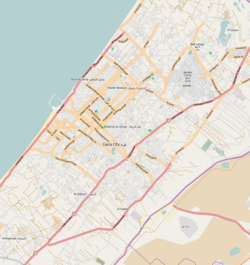Zaytun Quarter
Zeitoun
الزيتون | |
|---|---|
Neighborhood | |
| Zaitoun | |
| Coordinates: 31°29′28.28″N 34°26′38.8″E / 31.4911889°N 34.444111°E | |
| State | State of Palestine |
| Governorate | Gaza Governorate |
| City | Gaza |
| Time zone | UTC+2 (EET) |
| • Summer (DST) | +3 |
Al-Zaytun (also spelled Zeitoun or Harat az-Zaytoun; Arabic: الزيتون; Arabic translation: "the Quarter of Olive trees"[1]) is the southwestern and largest quarter of the Old City of Gaza.[2] Prior to the demolition of the Old City's walls, it was one of the three walled quarters of Gaza's Old City, the other two being al-Tuffah in the northeast and al-Daraj in the northwest. Omar Mukhtar Street, Gaza City's main thoroughfare, separates al-Zaytun from al-Daraj.[3]
History
[edit]The northwestern part of al-Zaytun was known as "Dar al-Khudar" ("the Vegetable House"), which was a small subdivision that contained the open-air vegetable market known as "Suq al-Khudar". In 1525, Dar al-Khudar contained 43 households,[4] while Zaytun, the south eastern part of present Al-Zaytun, had 54 households and 30 bachelors,[5] and Nasara, close to the Church of Saint Porphyrius, had 82 households.[6]
The Christian and Jewish neighborhoods of Gaza were also a part of al-Zaytun. The 5th century Saint Porphryrius Church, belonging to the Greek Orthodox denomination, is located in al-Zaytun and stands alongside the 14th century Kateb al-Welaya Mosque, with only two meters of space in between the former's bell tower and the latter's minaret. Adjacent to the church is the old Christian graveyard.[3] Also located in al-Zaytun is the al-Shamah Mosque.[7]
The last Jewish residents of al-Zaytun were evacuated by the British army following the 1929 Palestine riots.
It was expanded in the 1930s and 1940s as Gaza developed outside its center. Much of the funding for the initial construction is attributed to foreign institutions, such as missionary hospitals.[8] After the 1948 Arab-Israeli War, with the influx of Palestinian refugees, Zeitoun's population swelled. Ahmed Yassin's family settled the district in the 1950s.[9]
Gaza War (2008–2009)
[edit]During the 2008–2009 Israel–Gaza conflict, the Israel Defense Forces (IDF) launched a ground incursion in the area, occupying the district. During this period, 48 Palestinians, mostly from three families, were killed. In addition, 27 homes, a number of farms, and a mosque were destroyed.
References
[edit]- ^ Palmer, p. 359
- ^ Sharon, Moshe (2009). "Gaza". Corpus Inscriptionum Arabicarum Palaestinae. Vol. 4. BRILL. pp. 28–30. ISBN 90-04-17085-5.
The old city of Gaza, where all the remnants of the ancient, medieval and early Ottoman city are found, is divided into four quarters, a few of which are subdivided. Three of these quarters (at-Tuffäh, ad-Daraj, and az-Zaytun) were within the walls of the ancient city. The southeastern quarter, as-Saja'iyyah, developed later than the others, mainly outside these walls… The four quarters of the city are as follows… In the southwest (generally: south): Hãrat (or Hayy) az-Zaytün (the "Olive Quarter") called thus because of its olive groves. It is the largest quarter of Gaza… The Daraj Quarter is separated from the Zaytün Quarter by a wide road built during WWI by Jamãl Pasha. He ordered the demolition of a great part of the medieval Khãn az-Zayt to make room for the road to which he gave his name. The city council however, decided to change its name to 'Umar al-Mukhtär Street…
- ^ a b Sharon, 2009, p. 30
- ^ Sharon, 2009, p. 29
- ^ Cohen and Lewis, 1978, p. 117
- ^ Cohen and Lewis, 1978, p. 119
- ^ Sharon, 2009, p. 31
- ^ Dumper, Abu-Lughod, and Stanley, 2007, p.156.
- ^ Milton-Edwards, 1999, p.98.
Bibliography
[edit]- Cohen, Amnon; Lewis, Bernard (1978). Population and Revenue in the Towns of Palestine in the Sixteenth Century. Princeton University Press. ISBN 0-691-09375-X.
- Meyer, Martin Abraham (1907). History of the city of Gaza: from the earliest times to the present day. Columbia University Press.
- Palmer, E. H. (1881). The Survey of Western Palestine: Arabic and English Name Lists Collected During the Survey by Lieutenants Conder and Kitchener, R. E. Transliterated and Explained by E.H. Palmer. Committee of the Palestine Exploration Fund.
- Sharon, Moshe (2009). Corpus Inscriptionum Arabicarum Palaestinae, G. Vol. 4. BRILL. ISBN 90-04-17085-5.
- Dumper, Michael; Stanley, Bruce E.; Abu-Lughod, J. (2007), Cities of the Middle East and North Africa: A Historical Encyclopedia, ABC-CLIO, ISBN 978-1-57607-919-5
- Milton-Edwards, Beverley (1999), Islamic Politics in Palestine, I.B.Tauris, ISBN 978-1-86064-475-7
External links
[edit]- Survey of Western Palestine, Map 19: IAA, Wikimedia commons

